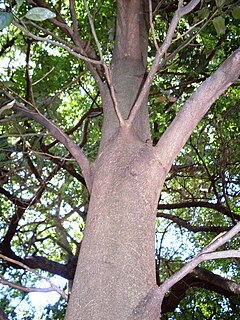
Cryptocarya foetida is a rainforest tree growing at the eastern coastal parts of Australia. The common name is due to the allegedly offensive odour given by the flowers. The stinking cryptocarya or stinking laurel is considered vulnerable to extinction with a ROTAP rating of 3VC.

Cryptocarya glaucescens, commonly known as jackwood, is a rainforest tree of the laurel family growing in eastern Australia.

Endiandra sieberi, known as the corkwood is a rainforest tree growing in eastern Australia.

Cryptocarya obovata is a species of laurel growing on basaltic and fertile alluvial soils in eastern Australian rainforests. It is found from Wyong in New South Wales to Gympie in the state of Queensland. Extinct in the Illawarra region, allegedly seen in the Illawarra in 1818 by Allan Cunningham. The species was included in the Prodromus Florae Novae Hollandiae et Insulae Van Diemen, 402 (1810)
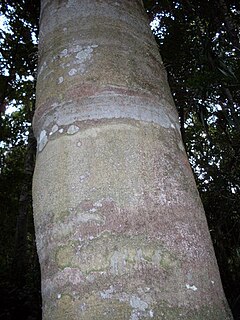
Symplocos stawellii, or the white hazelwood, is a rainforest tree growing in eastern Australia. It often grows along creeks in gullies, in tropical and sub-tropical rainforests. The natural distribution is from Gerringong Creek in the upper Kangaroo Valley of New South Wales to the Atherton Tableland in tropical Queensland. It also occurs in New Guinea.
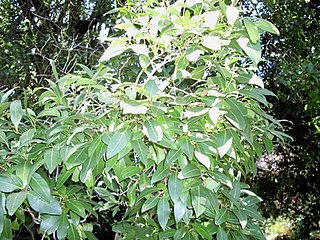
Beilschmiedia elliptica, known as the grey walnut is a rainforest laurel growing in eastern Australia. The range of natural distribution is from Forster, New South Wales to Fraser Island in south eastern Queensland. Beilschmiedia elliptica grows in warm temperate and sub tropical rainforests. Not a rare species, but seldom identified in the rainforest.

Gossia bidwillii, known as the python tree is a rainforest myrtle of eastern Australia.The usual habitat is the drier rainforest areas. The range of natural distribution is from the Hunter River in New South Wales to Coen in far northern Queensland.

Myrsine variabilis, synonym Rapanea variabilis, known as the muttonwood or variable muttonwood is a tree of eastern Australia. The range of natural distribution is from near Milton in southern New South Wales to the McIlwraith Range in far north Queensland.

Cryptocarya laevigata, known as the glossy laurel or red-fruited laurel, is a rainforest plant growing in eastern Australia. The natural range of distribution is rainforest understorey on fertile soils, from the Richmond River, New South Wales to Cairns in tropical Queensland. Often seen in association with the White Booyong.

Cryptocarya foveolata, known as the mountain walnut is a rainforest tree growing at high altitude in eastern Australia. Despite the common name, it belongs to the laurel family.

Cryptocarya triplinervis is a rainforest tree growing in eastern Australia. Common names include the three veined laurel, three veined cryptocarya and the brown laurel.

Cryptocarya meissneriana, known as the thick-leaved laurel is a small tree growing in eastern Australia. The habitat is rainforest on the poorer sedimentary soils.

Maytenus silvestris is a shrub or small tree growing from Picton, New South Wales near Kroombit Tops, near Gladstone, Queensland. It occurs in dry rainforest, eucalyptus and rainforest ecotone areas. Common names include narrow leaved orangebark, orange bush and orange bark.

Elattostachys nervosa, known as the green tamarind or beetroot tree is a common rainforest tree of eastern Australia. Found in all types of rainforest, growing from Paterson, New South Wales in the south to Gympie in south east Queensland. The name Elattostachys refers to "little spikes", a flower feature of other plants in this genus. Nervosa refers to the prominent leaf venation. Beetroot Tree refers to the beetroot red leaves of the new growth.
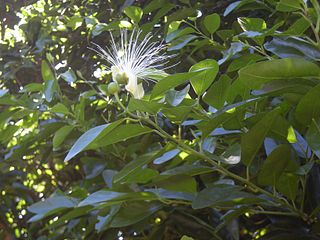
Capparis arborea is a bush or small tree occurring in eastern Australia. The habitat is rainforest; usually riverine, littoral or the drier rainforests. Distributed from the Hunter River, New South Wales to Cape Melville in tropical Queensland. Common names include native pomegranate, wild lime, wild lemon and brush caper berry.
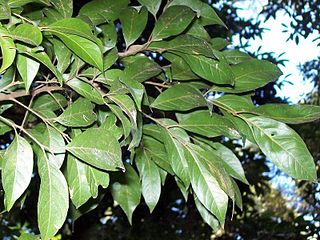
Sarcopteryx stipata, known as the steelwood, is a rainforest tree of eastern Australia occurring from the Bulga Plateau and Comboyne Plateau north west of Taree, New South Wales as far north as Fraser Island off the coast of south eastern Queensland. It grows in sub tropical rainforest but sometimes occurs in warm temperate rainforests on poorer soils. It is a member of the soap berry family. The generic name Sarcopteryx translates to "fleshy wing", as the fruit can be wing shaped. Stipata means "surrounded". The common name steelwood refers to the very tough, hard and heavy timber.

Mischocarpus pyriformis, known as the pear fruited tamarind is a rainforest tree of eastern Australia. Occurring from Seal Rocks, New South Wales to as far north as Cooktown in tropical Queensland. The sub species found in New South Wales is Mischocarpus pyriformis subsp. pyriformis.
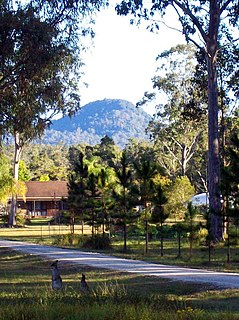
Cryptocarya floydii is an Australian rainforest tree. It occurs in steep dry rocky gullies in northern New South Wales and adjacent areas in Queensland as far north as Bunya Mountains National Park. It grows as far south as the upper gullies of the Guy Fawkes River and the Macleay River. The common name is gorge laurel or Glenugie laurel, after the type locality of Glenugie Peak, near Grafton, New South Wales.

Cryptocarya nova-anglica, the mountain laurel, is a rainforest tree growing in eastern Australia. The habitat is a restricted distribution in cool temperate rainforest mostly over 1,100 metres (3,609 ft) in altitude. The range of natural distribution is from the upper Hastings River to near the border of the state of Queensland. It is an understorey tree, associated with the Antarctic beech, possumwood, golden sassafras and black olive berry trees.
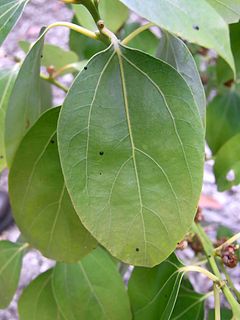
Neolitsea australiensis, also known as the green bolly gum, is an Australian rainforest tree, in the laurel family. The specific epithet is derived from "Australia", and the Latin "ensis"; meaning "native of Australia".




















